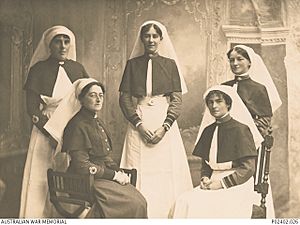Matron facts for kids
A matron is a very important and senior nurse. This job title is used in countries like the United Kingdom, the Republic of Ireland, and other Commonwealth countries. Matrons are usually in charge of many nurses and other staff in a hospital.
What is a Matron?
The main nurse in a hospital, who leads all the nursing staff, has different names around the world. They might be called a Chief Nursing Officer, Chief Nursing Executive, or Director of Nursing. In the UK, they are often known as a matron or Clinical Nurse Manager. In India, they are called a nursing superintendent or matron.
In the United Kingdom today, matrons have a lot of power. They can manage budgets, and they oversee things like catering and cleaning services. They can even stop payments to these services if they are not doing a good job for the NHS. Historically, matrons looked after the whole hospital. Now, they usually supervise two or three wards (sections of a hospital).
A chief nurse is a registered nurse. They make sure all patients get good care at a healthcare place. This is a very senior job in nursing management. These leaders often have titles like Chief Nursing Officer (CNO) or Vice-President of Nursing. They usually report to the hospital's main boss, like the CEO.
The word "matron" comes from a Latin word meaning "mother." It came into English through French.
History of Matrons
Before about 1972 in the United Kingdom, the matron was the most senior nurse in a hospital. They were in charge of all the nurses and cleaning staff. They also oversaw all patient care and made sure the hospital ran smoothly. Matrons were almost always women, as male nurses were not common in senior roles back then.
People often saw matrons as strict leaders. But nurses and doctors respected them. Matrons also worked in UK boarding schools from the 1950s to the 1990s. They looked after students, similar to how they managed nurses. They even assigned chores as punishment, like laundry or cleaning. Matrons also checked that students wore their uniforms correctly and made their beds neatly.
The matron became a famous character in British films like Carry On Nurse (1959) and Carry On Doctor (1963). Actress Hattie Jacques often played these roles. Matrons usually wore a special uniform. It was often a dark blue dress with a fancy headdress.
Modern Matrons
In 2001, the British Government brought back the matron role to the NHS. They called them "modern matrons." This was done to help improve hospitals, which some people said were dirty or had poorly behaved staff.
Modern matrons do not have as much responsibility as the old matrons. They often oversee just one department, like surgery or the emergency department. This means a large hospital might have many matrons. They do control budgets for catering and cleaning. In bigger hospitals, some matrons manage a group of wards.
Their management powers are more limited. They spend most of their time on office work instead of directly caring for patients.
Many areas in the UK now have Community Matrons. These matrons mostly do clinical work. They look after patients with long-term health problems, like breathing issues. Their goal is to treat patients at home to avoid hospital visits. Most Community Matrons are nurses, but some are paramedics or occupational therapists.
The nursing parts of the British Armed Forces still use the term "Matron." It is used for both male and female officers, usually those with the rank of Major or higher.
In South Africa and Namibia, "Matron" is the title for the most senior nurse in a hospital.
Other Uses of Matron
For a long time, before women became full police officers, police forces hired uniformed women called "police matrons." They had limited powers to search and help female prisoners and deal with issues affecting women and children. Officers in women's prisons also sometimes used the title "matron."
Places like children's homes and workhouses also had matrons. The matron of a workhouse was often the master's wife. She looked after the daily running of the place. This was actually the first meaning of the word "matron." Its use in hospitals came from workhouses.
The term was also used in boarding schools. Some British independent schools still use it today. It refers to the woman in charge of domestic matters in a boarding house or the school nurse.
In The Church of Jesus Christ of Latter-day Saints, the wife of a temple president is called a temple matron.
In New York City, movie theaters hired "movie theater matrons" starting in 1936. Their job was to make sure children behaved in the theaters.


